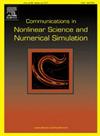介电弹性体作动器驱动振动冲击胶囊机器人的对比研究
IF 3.4
2区 数学
Q1 MATHEMATICS, APPLIED
Communications in Nonlinear Science and Numerical Simulation
Pub Date : 2025-04-12
DOI:10.1016/j.cnsns.2025.108866
引用次数: 0
摘要
由介电弹性体作动器驱动的冲击振动胶囊机器人具有结构简单、运动效率高等特点。在一个DEA框架上堆叠多层膜是一种广泛采用的方法,以增加DEA的功率和功输出,然而,利用多层DEA来提高DEA驱动的振动冲击胶囊机器人的运动性能的有效性尚不清楚。为此,本文首先对多层dea驱动的冲击振动胶囊机器人的运动性能进行了全面的数值研究。仿真结果表明,随着DEA层数的增加,机器人的运动速度降低是违反直觉的,并分析了导致速度降低的可能因素。其次,本文介绍了一种新的驱动方案,该方案将DEA中的多层分离。仿真结果表明,当一个DEA的驱动电压在50°~ 75°之间相对领先于其他DEA的驱动电压时,可以获得最大速度。通过使用三个dea,振动冲击胶囊机器人的最大速度提高了70%。通过实验验证了数值研究的关键结论,实验结果与仿真结果的一致性验证了模型的有效性。本文章由计算机程序翻译,如有差异,请以英文原文为准。
A comparative study on the dielectric elastomer actuator driven Vibro-impact capsule robot
Vibro-impact capsule robots driven by dielectric elastomer actuators (DEAs) feature simple structures and high locomotion efficiencies. Stacking multiple layers of membranes on one DEA frame is a widely adopted approach to multiply the power and work output of the DEA, however, the effectiveness of utilizing a multi-layer DEA to boost the locomotion performance of DEA-driven vibro-impact capsule robots remains unclear. To this end, this paper first conducts a comprehensive numerical study on the locomotion performance of the multi-layer-DEA-driven vibro-impact capsule robots. Simulation results show the counterintuitive finding that the locomotion velocity of the robot reduces with the increasing number of layers in the DEA, and the possible factors leading to such reductions in velocity are analyzed. Next, this paper introduces a new driving scheme whereby multiple layers in The DEA are separated. Simulation results indicate that maximum velocity can be achieved by having the actuation voltages for one DEA lead the others by a relative phase between 50° to 75° as the dominant vibro-impact driving source. Improvements in the maximum velocity of the vibro-impact capsule robot by up to 70 % are achieved by using three DEAs. The key findings of the numerical studies are validated through experiments, and the consistency between the experimental and simulation results demonstrates the validity of the model.
求助全文
通过发布文献求助,成功后即可免费获取论文全文。
去求助
来源期刊

Communications in Nonlinear Science and Numerical Simulation
MATHEMATICS, APPLIED-MATHEMATICS, INTERDISCIPLINARY APPLICATIONS
CiteScore
6.80
自引率
7.70%
发文量
378
审稿时长
78 days
期刊介绍:
The journal publishes original research findings on experimental observation, mathematical modeling, theoretical analysis and numerical simulation, for more accurate description, better prediction or novel application, of nonlinear phenomena in science and engineering. It offers a venue for researchers to make rapid exchange of ideas and techniques in nonlinear science and complexity.
The submission of manuscripts with cross-disciplinary approaches in nonlinear science and complexity is particularly encouraged.
Topics of interest:
Nonlinear differential or delay equations, Lie group analysis and asymptotic methods, Discontinuous systems, Fractals, Fractional calculus and dynamics, Nonlinear effects in quantum mechanics, Nonlinear stochastic processes, Experimental nonlinear science, Time-series and signal analysis, Computational methods and simulations in nonlinear science and engineering, Control of dynamical systems, Synchronization, Lyapunov analysis, High-dimensional chaos and turbulence, Chaos in Hamiltonian systems, Integrable systems and solitons, Collective behavior in many-body systems, Biological physics and networks, Nonlinear mechanical systems, Complex systems and complexity.
No length limitation for contributions is set, but only concisely written manuscripts are published. Brief papers are published on the basis of Rapid Communications. Discussions of previously published papers are welcome.
 求助内容:
求助内容: 应助结果提醒方式:
应助结果提醒方式:


